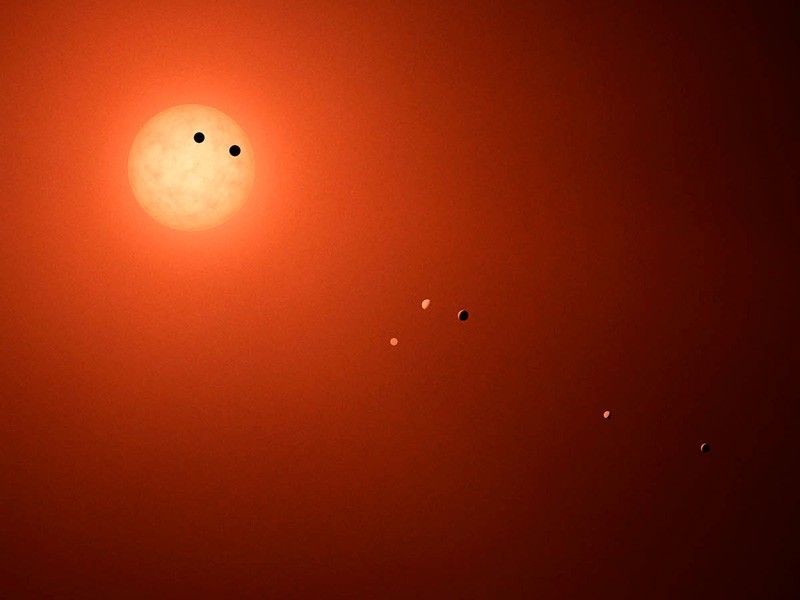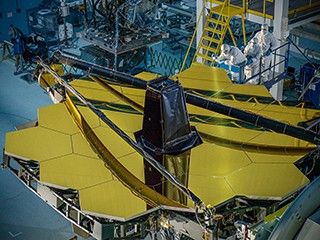Largest Batch of Earth-size Habitable Zone Planets Found Orbiting TRAPPIST-1
TRAPPIST-1: Largest Batch of Earth-sized Exoplanets
The most studied planetary system, aside from our own solar system, lies about 40 light-years away. We've looked at the seven rocky exoplanets orbiting the TRAPPIST-1 star with ground and space telescopes like Spitzer, Kepler, Hubble, and, now, the James Webb Space Telescope.
In March 2023, the first science from the Webb telescope was released. An analysis of TRAPPIST-1b, the innermost planet, revealed its dayside temperature and found little evidence of an atmosphere.
In a press release on February 22, 2017, NASA announced the discovery of the most Earth-sized planets found in the habitable zone of a single star, called TRAPPIST-1. This system of seven rocky worlds–all of them with the potential for water on their surface – is an exciting discovery in the search for life on other worlds. There is the possibility that future study of this unique planetary system could reveal conditions suitable for life.
In February 2018, closer study of the seven planets suggested that some could harbor far more water than the oceans of Earth, in the form of atmospheric water vapor for the planets closest to their star, liquid water for others, and ice for those farthest away. The study pinned down the density of each planet more precisely, making TRAPPIST-1 the most thoroughly known planetary system apart from our own.
A 2021 study revealed more about TRAPPIST-1 planets. They are likely made of similar stuff, but they are different from Earth. That could mean they all contain about the same ratio of materials thought to compose most rocky planets, like iron, oxygen, magnesium, and silicon. But if this is the case, that ratio must be notably different than Earth's: The TRAPPIST-1 planets are about 8% less dense than they would be if they had the same makeup as our home planet.
Exoplanet surface in 360 VR
An artist's illustration of TRAPPIST-1d takes you to the surface of the third planet from the red TRAPPIST-1 star. From here, the star looms larger than our Sun and its light casts a red glow across the sky. Look up, and you may catch a glimpse of its six sister planets, as visible as our Moon is from Earth. View on YouTube
Planet hop from TRAPPIST-1 e
Take a trip with the Exoplanet Travel Bureau to the fourth planet in the TRAPPIST-1 system, TRAPPIST-1 e, a world swimming in water in perpetual twilight. Its sister planets gracefully light up the sky, promising another adventure just a hop away.
Download your own free poster
-
Interact with the TRAPPIST-1 system in 3D
You can fly through the TRAPPIST-1 planets and see an artist's concept of the surfaces, on your phone or with a desktop app. Compare each planet to Earth or Jupiter, compare the TRAPPIST-1 system to our solar system, and see how far the habitable zone extends.
With the touch of a screen or the click of a mouse, you can visit the recently discovered TRAPPIST-1 system in our Exoplanet Catalog. It contains every exoplanet discovery, powered by NASA's Exoplanet Archive, the official database used by professional astronomers engaged in exploring new worlds.

Latest images and videos
More TRAPPIST-1 images




Before and After
Trappist-1 system Spitzer findings
Before and after the discovery of four new planets
Related Videos

Not so strange new worlds
Since 2017, we knew the TRAPPIST-1 system had seven Earth-sized planets. Now in 2018, a study using new data – including extensive observations by NASA's Spitzer and Kepler space telescopes – has provided more information about this amazing system.

Hubble probes atmospheres of exoplanets in TRAPPIST-1 habitable zone
Astronomers using the Hubble Space Telescope have conducted the first spectroscopic survey of Earth-sized planets in the TRAPPIST-1 system’s habitable zone.

News conference images and videos
See the TRAPPIST-1 gallery of art and animations at Caltech's Spitzer telescope site, as of Feb 2017.

NASA news conference
Archived footage of the NASA news conference announcing the discovery of the seven TRAPPIST-1 planets on February 22, 2017.

Treasure trove of planets
This video features interviews with the scientists who discovered the system of seven planets orbiting TRAPPIST-1, an ultra-cool dwarf star.

Weirdest habitable worlds
How would life be different around a red star? While we don’t know if there is life on the TRAPPIST-1 planets, we do know that any life discovered there would likely be very different from life on Earth.

Seven wonders of TRAPPIST-1
This video details a system of seven planets orbiting TRAPPIST-1, a discovery of the Spitzer Space Telescope, operated by NASA's Jet Propulsion Laboratory in Pasadena, California.

500 hours
This animation visualizes the change in light as each planet passes in front of its star. The study established the planets' size, distance from their sun and, for some of them, their approximate mass and density.

How do we know what air is like on other planets?
How do we know what the air is like on planets we haven't visited? This James Webb Space Telescope video explains how to see air from 150 light-years away.

Animation: Planetary orbits and transits
An animation of the seven TRAPPIST-1 planets transiting in front of their red dwarf star.

Animation: TRAPPIST-1 planets flyaround
This video depicts artist's concepts of each of the seven planets orbiting TRAPPIST-1, an ultra-cool dwarf star. The planets appear in the order of innermost to outermost planets.

Animation: Spitzer Space Telescope
This animation portrays NASA's Spitzer Space Telescope in space.
Related Articles

Can life survive on a TRAPPIST-1 planet?
A bumper crop of Earth-sized planets huddled around a red dwarf star could be little more than chunks of rock blasted by radiation. Or they could harbor exotic lifeforms, thriving under orange twilight skies.

NASA's Spitzer Space Telescope news
The extraordinary TRAPPIST-1 finding was made possible with 21 days of near-continuous Spitzer Space Telescope observations of the ultra-cool M-dwarf.

Ultracool Dwarf and the Seven Planets
The European Southern Observatory's news release describes the temperate Earth-sized worlds found in an extraordinarily rich planetary system.









































